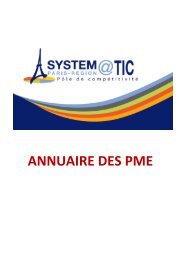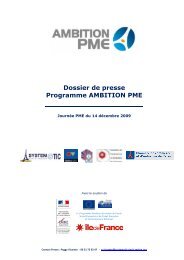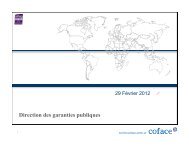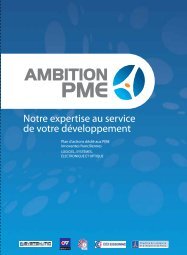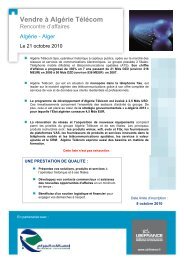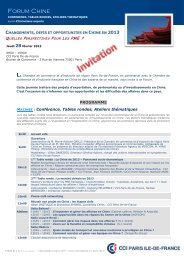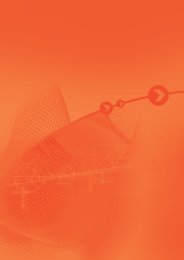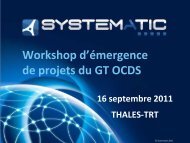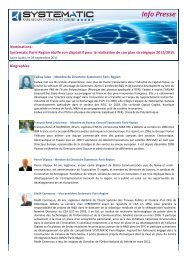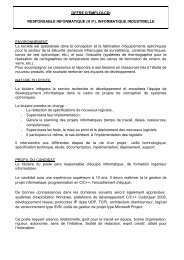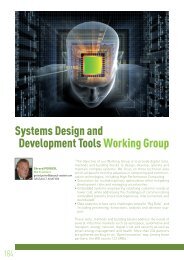- Page 2 and 3: ContentsSystematic World Class Comp
- Page 4 and 5: 6ContentsCOUVERTURE Embedded 132DAT
- Page 6 and 7: 8ContentsSTIMULEE Modelling systems
- Page 8 and 9: World Class Competitiveness Cluster
- Page 10 and 11: © Renault © VINCENT, HubertAutomo
- Page 12 and 13: Diagnosis0-DEFECTOutil de Diagnosti
- Page 14 and 15: Algorithms & data fusionfor localis
- Page 16 and 17: Software tools and MethodsCost-Effi
- Page 18 and 19: Human-Machine interfacesCOllaboRati
- Page 20 and 21: DiagnosisDIAPADIagnostic Automobile
- Page 22 and 23: Algorithms & data fusionfor localis
- Page 24: Software tools and MethodsHECOSIMHe
- Page 27 and 28: Electronics ArchitectureIMOFISIngé
- Page 29 and 30: Human-Machine interfacesIntegrated
- Page 31 and 32: Human-Machine interfacesLIMALight I
- Page 33 and 34: Electronics ArchitectureMASCOTTEMAi
- Page 35 and 36: Software tools and MethodsFrom Syst
- Page 37 and 38: Software tools and MethodsO4A2Open
- Page 39: Electronics ArchitecturePETRAPlatef
- Page 43 and 44: Electronics ArchitectureSystèmes C
- Page 45 and 46: Human-Machine interfacesSIFORASSImu
- Page 47 and 48: DiagnosisSODDASoft Defects Diagnosi
- Page 49 and 50: Dependability ofmonitoring systemsS
- Page 52 and 53: Digital Trust & SecurityWorking Gro
- Page 54 and 55: Critical Infrastructure protectionE
- Page 56 and 57: Trust and security in large transac
- Page 58 and 59: Critical Infrastructure protectionB
- Page 60 and 61: Critical Infrastructure protectionB
- Page 62 and 63: Critical Infrastructure protectionC
- Page 64 and 65: Critical Infrastructure protectionD
- Page 66 and 67: Comprehensive risk management,preve
- Page 68 and 69: Trust and security in large transac
- Page 70 and 71: Trust and security in large transac
- Page 74 and 75: Critical Infrastructure protectionL
- Page 76 and 77: Digital Trust for citizensLightweig
- Page 78 and 79: Critical Infrastructure protectionM
- Page 80 and 81: Critical Infrastructure protectionM
- Page 82 and 83: Critical Infrastructure protectionM
- Page 84 and 85: Social and societal aspects,Social
- Page 86 and 87: Trusted Infrastructurefor smart cit
- Page 88 and 89: Digital Trust for citizensPassword
- Page 90 and 91:
Trust and security in large transac
- Page 92 and 93:
Trust and security in large transac
- Page 94 and 95:
Critical Infrastructure protectionR
- Page 96 and 97:
Critical Infrastructure protectionS
- Page 98 and 99:
Comprehensive risk management,preve
- Page 100 and 101:
Trust and security in large transac
- Page 102 and 103:
Digital Trust for citizensSECULARSe
- Page 104 and 105:
Trusted Infrastructurefor smart cit
- Page 106 and 107:
Critical Infrastructure protectionS
- Page 108 and 109:
Critical Infrastructure protectionS
- Page 110 and 111:
Critical Infrastructure protectionS
- Page 112 and 113:
Critical Infrastructure protectionS
- Page 114 and 115:
Trust and security in large transac
- Page 116 and 117:
Trust and security in large transac
- Page 118 and 119:
Trust and security in large transac
- Page 120:
Critical Infrastructure protectione
- Page 123 and 124:
FREE & OPEN SOURCE SOFTWARE, FROM D
- Page 125 and 126:
Web 2.0 and 3.0FWOSRSEOpen-source f
- Page 127 and 128:
Development toolsCOnvergence de la
- Page 129 and 130:
MiddlewareCompatibleOneON GOINGPROJ
- Page 131 and 132:
Web 2.0 and 3.0Data PublicaCOMPLETE
- Page 133 and 134:
Development toolsDORMDerived Object
- Page 135 and 136:
MiddlewareEASYSOAEasySOAON GOINGPRO
- Page 137 and 138:
Software engineering /Development t
- Page 139 and 140:
MiddlewareINFRA-JVMTowards a Java V
- Page 141 and 142:
DistributedDistributed transactiona
- Page 143 and 144:
Web 2.0 and 3.0Programmation du Web
- Page 145 and 146:
EmbeddedReal Time Embedded LinuxFor
- Page 147 and 148:
Development toolsSoftware QUALity E
- Page 149 and 150:
Development toolsTYPEXTypeful certi
- Page 152 and 153:
PRIORITIES AND PROJECTSCap Digital,
- Page 154 and 155:
NEW CHALLENGESEnergy systems are un
- Page 157 and 158:
162Systems Design andDevelopment To
- Page 159 and 160:
Modelling systems simulationADNAlli
- Page 161 and 162:
Software engineeringACOSEAtelier po
- Page 163 and 164:
Software engineeringAtelier de Dév
- Page 165 and 166:
Software engineeringAGREGATIONContr
- Page 167 and 168:
Modelling systems simulationAquatea
- Page 169 and 170:
Software engineeringStatic Analysis
- Page 171 and 172:
Modelling systems simulationProject
- Page 173 and 174:
Modelling systems simulationCAMPASC
- Page 175 and 176:
Software engineeringCERtification C
- Page 177 and 178:
Software engineeringCHAPICalcul emb
- Page 179 and 180:
Software engineeringConception et C
- Page 181 and 182:
Modelling systems simulationCOntrô
- Page 183 and 184:
Software engineeringConfidence, Pro
- Page 185 and 186:
Software engineeringDesign of fixed
- Page 187 and 188:
Modelling systems simulationEHPOCHi
- Page 189 and 190:
Software engineeringENERGY POSITIVE
- Page 191 and 192:
Software engineeringEVODEducational
- Page 193 and 194:
Modelling systems simulationCOMPLET
- Page 195 and 196:
Software engineeringInfrastructures
- Page 197 and 198:
Modelling systems simulationFramewo
- Page 199 and 200:
Data analyticsHigh Performance imag
- Page 201 and 202:
Modelling systems simulationINDIACI
- Page 203 and 204:
Modelling systems simulationIOLSInf
- Page 205 and 206:
Modelling systems simulationIRIMIIm
- Page 207 and 208:
Modelling systems simulationJeu Edu
- Page 209 and 210:
Software engineeringLibraries for A
- Page 211 and 212:
Software engineeringMANYCORELABSSof
- Page 213 and 214:
Software engineeringMHANNMemristive
- Page 215 and 216:
Modelling systems simulationMOHYCAN
- Page 217 and 218:
Software engineeringMOdelling VIews
- Page 219 and 220:
Modelling systems simulationN-POEMN
- Page 221 and 222:
Modelling systems simulationphase 2
- Page 223 and 224:
Software engineeringOCELLEOutils Lo
- Page 225 and 226:
Modelling systems simulationOPARUSO
- Page 227 and 228:
Modelling systems simulationOpen HP
- Page 229 and 230:
Modelling systems simulationOPTIDIS
- Page 231 and 232:
Software engineeringPROJET PProjet
- Page 233 and 234:
Software engineeringPANDAParallelis
- Page 235 and 236:
Modelling systems simulationPARMATP
- Page 237 and 238:
Software engineeringPErformances GA
- Page 239 and 240:
Software engineeringPICADODevelopme
- Page 241 and 242:
Software engineeringPPRPlateforme d
- Page 243 and 244:
Modelling systems simulationPUMACOM
- Page 245 and 246:
Modelling systems simulationRADIOLA
- Page 247 and 248:
Modelling systems simulationSimulat
- Page 249 and 250:
Software engineeringREVERProgrammin
- Page 251 and 252:
Modelling systems simulationROMMARO
- Page 253 and 254:
Software engineeringSALTYSelf-Adapt
- Page 255 and 256:
Modelling systems simulationSHANSha
- Page 257 and 258:
Modelling systems simulationSICODYN
- Page 259 and 260:
Modelling systems simulationSISTAES
- Page 261 and 262:
Modelling systems simulationCOMPLET
- Page 263 and 264:
Modelling systems simulatioSTURM4Si
- Page 265 and 266:
Modelling systems simulationSystem
- Page 267 and 268:
Modelling systems simulationTRIDIMI
- Page 269 and 270:
Software engineeringUSINELOGICIELLE
- Page 271 and 272:
Modelling systems simulationUSINENU
- Page 273 and 274:
Software engineeringVAUCANSON 2Vauc
- Page 275 and 276:
Software engineeringVERification-or
- Page 277 and 278:
Software engineeringWAAVES GPWAAVES
- Page 279:
Software engineeringWind energy Int
- Page 282 and 283:
REQUIREMENTS AND NEW USESInformatio
- Page 284 and 285:
Wireless Connectivity3MINGMobilité
- Page 286 and 287:
High speed networksHigh Performance
- Page 288 and 289:
Wireless ConnectivityAntenne Mobile
- Page 290 and 291:
Wireless ConnectivityATTITUDE 4G+Ar
- Page 292 and 293:
High speed networksCAlcul Réparti
- Page 294 and 295:
High speed networksCHRONOSChromatic
- Page 296 and 297:
High speed networksCOHDEQ40COHerent
- Page 298 and 299:
High speed networks /Wireless Conne
- Page 300 and 301:
Personalised Services & Communicati
- Page 302 and 303:
High speed networksECOFRAMEElément
- Page 304 and 305:
High speed networkseco-design of ho
- Page 306 and 307:
Wireless ConnectivityELHANE-Band po
- Page 308 and 309:
Personalised Services& Communicatio
- Page 310 and 311:
Personalised Services& Communicatio
- Page 312 and 313:
High speed networksHigh Spectral Ef
- Page 314 and 315:
Personalised Services& Communicatio
- Page 316 and 317:
High speed networksJASMINJump-up of
- Page 318 and 319:
Algorithms & data fusionfor localis
- Page 320 and 321:
Personalised Services& Communicatio
- Page 322 and 323:
High speed networksMICROSMultilevel
- Page 324 and 325:
High speed networks /Wireless Conne
- Page 326 and 327:
Personalised Services& Communicatio
- Page 328 and 329:
Wireless ConnectivityPilOte de Serv
- Page 330 and 331:
Wireless ConnectivityQoS garanties
- Page 332 and 333:
QoEQuality of Experience Estimators
- Page 334 and 335:
Wireless ConnectivityRéseau de Com
- Page 336 and 337:
Wireless ConnectivitySeamless and a
- Page 338 and 339:
Personalised Services& Communicatio
- Page 340 and 341:
Wireless ConnectivityS4TSmart4G Tab
- Page 342 and 343:
Personalised Services& Communicatio
- Page 344 and 345:
Personalised Services& Communicatio
- Page 346 and 347:
High speed networksModules de Trans
- Page 348 and 349:
Wireless ConnectivityUBIQ-XPUBIQ-XP
- Page 350 and 351:
Personalised Services& Communicatio
- Page 352 and 353:
High speed networksVERSO-MODULESour
- Page 355 and 356:
360Index ofManagement Board Members
- Page 357 and 358:
362Steering commitees membersFREE &
- Page 359 and 360:
The Cluster and its R&D projectsare
- Page 361 and 362:
366Projects alphabetical list0-DEFA
- Page 363 and 364:
368Projects alphabetical listNEOPPO
- Page 365 and 366:
370Last minuteFUI and Regional coll
- Page 367 and 368:
372Member’salphabetical listSME3D
- Page 369:
L 28/04/08 11:35 PaPEFC/10-31-1240F



